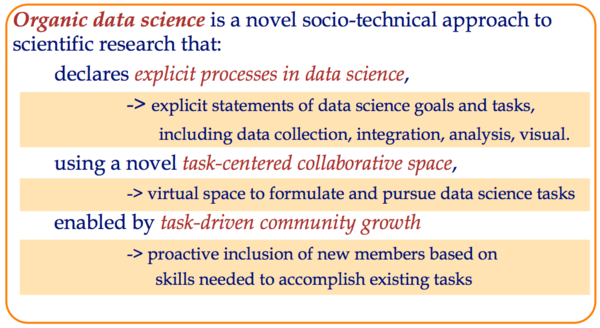Difference between revisions of "Framework Design"
From Organic Data Science Framework
(→Social Design Principles) |
|||
| Line 11: | Line 11: | ||
==Social Design Principles== | ==Social Design Principles== | ||
| + | |||
| + | '''STATUS: This section is still under development''' | ||
| + | |||
===Starting Communities=== | ===Starting Communities=== | ||
# <b>Create mechanisms to match people to activities</b> <br/> <div style="font-size:smaller; color:gray;">Partly addressed by: [[Task Representation]]</div> | # <b>Create mechanisms to match people to activities</b> <br/> <div style="font-size:smaller; color:gray;">Partly addressed by: [[Task Representation]]</div> | ||
Revision as of 10:28, 2 June 2014
Contents
Designing the Platform for Organic Data Science
The Organic Data Science platform represents the technical approach in Organic Data Science. Our goal is to develop a social computing system that supports collaborative science.
We use well-known principles for social collaboration, explained below, to guide the design of the platform. The implementation builds on a Semantic Wiki platform.
Social Design Principles
STATUS: This section is still under development
Starting Communities
- Create mechanisms to match people to activities
Partly addressed by: Task Representation - Highlight more active tasks
- Inactive tasks should have „expected active times“
Encouraging Contributions through Motivation
- Make it easy to see and track needed contributions
Addressed by: Task Representation, Explorer Navigation, Worklist, Task Alert, Timeline, User TrackingPartly addressed by: Progress Tracking - Ask specific people on tasks of interest to them
Addressed by: User Tracking - Simple tasks with challenging goals are easier to comply with Addressed by: Task Representation
- Specify deadlines for tasks, while leaving people in control
Partly addressed by: Explorer Navigation - Give frequent feedback specific to the goals
- Requests coming form leaders lead to more contributions
- Publicize that others have complied with request Partly addressed by: Worklist
- People are more willing to contribute: 1) when group is small, 2) when commited to the group, 3) when their contributions are unique
Encouraging Commitment
- Cluster members to help them identify with the community
Addressed by: User TrackingPartly addressed by: Explorer Navigation - Give subgroups a name and a taglinePartly addressed by: Task RepresentationExplorer Navigation
- Put subgroups in the context of a larger group Addressed by: Explorer NavigationPartly addressed by: Task Representation, Worklist
- Interdependent tasks increase commitment and reduce conflict
Addressed by: TimelinePartly addressed by: Task Representation, Worklist
